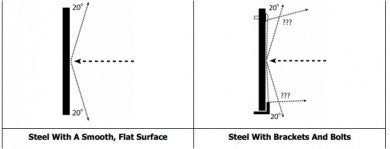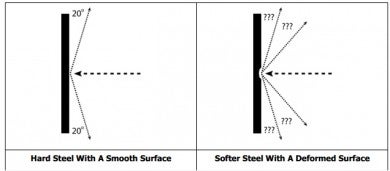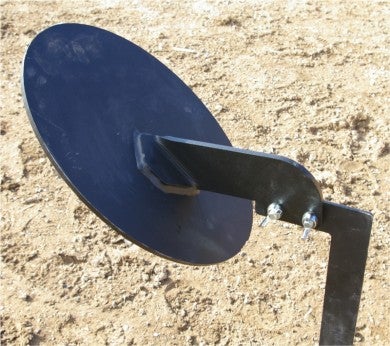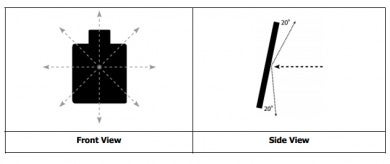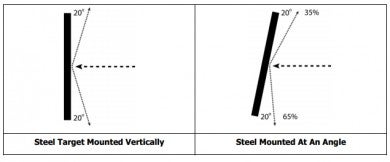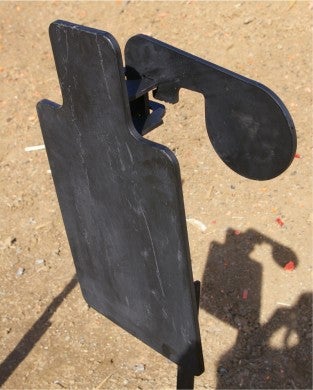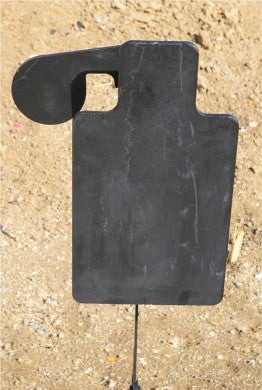Understanding the Safety of Steel Targets
Major Pandemic 03.29.14
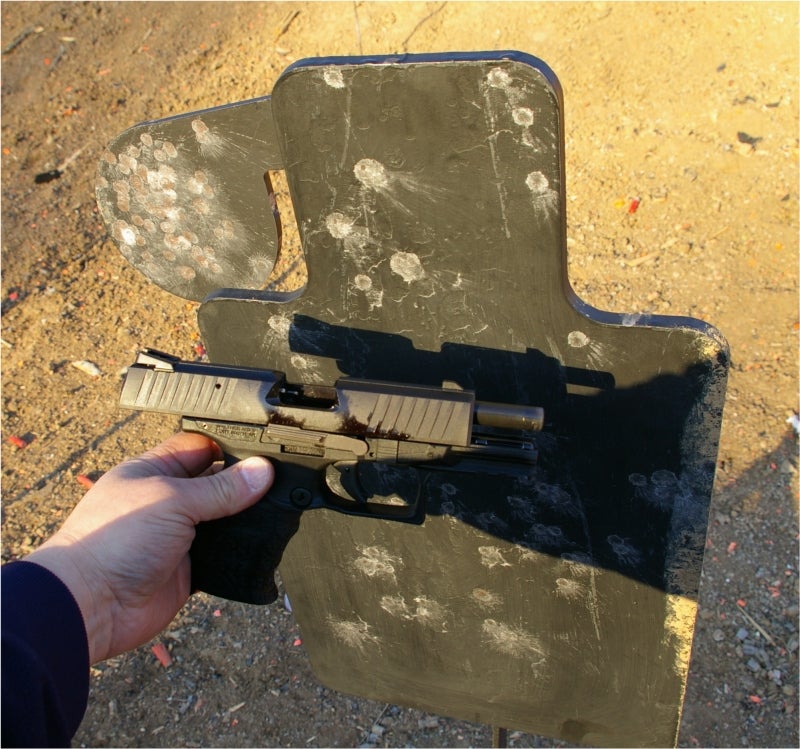
Over the years I’ve shot a lot of things, but the most fun and addictive are those metal targets that give an audible ting, bong, or clang when hit. If you have watched any shooting sports or tactical TV, then you know steel shooting targets are hugely popular for all areas of sport, target, and tactical training.
The advantages of steel targets go way beyond just the cool sound they make when hit. Steel targets make for a cleaner range and more efficient range visits due to the time saved from setting up targets and checking to see if you hit the target.
Steel targets are one of the most effective training aids a shooter can have at his/her disposal. The audible impact of steel delivers fast feedback, especially during rapid fire drills, and the bullet splashes record shot placement. Generally, just a quick blast of cheap spray paint renews, protects and resets the lead/copper marked target for your buddy to have his turn.
However, steel targets do have some dangers. I’m talking about ricochets, which I have experienced first-hand. I was hit twice in the chest with ricochets, and suffered a couple fractured ribs, two deep tissue bruises which extended in 12” radiuses on my body from the impact, and the privilege of being on blood thinners for almost four months during my recovery. For the record, this was “only” a couple .45 ACP hardball rounds that hit me after ricocheting off an “inspected and maintained” indoor range backstop over 20-yards away.
Ultimately, shooting steel seemed to just be asking for problems, and I for one am not terribly anxious to get hit again. This fear has generally limited my steel shooting to .22LR spinner targets, which dissipate almost all of the round’s energy.
Many ranges see enough such ricochets from steel that they permit only paper targets with pine wood based stands. All this put me on a quest for a better, safer, steel target for rimfire and centerfire handgun and rifle rounds.
I was excited to see the Action Target booth boldly claiming to be the “Safest Steel Targets” at this year’s SHOT Show, so I listened, asked a lot of questions, and then followed up with my own research. Here is what I found — not all steel targets are created equal.
Factors Affecting Safety
In theory, it would seem that there should be a higher risk when shooting steel targets, but that is not the case. When used properly with the right steel targets, ammo, and distance, the risk can actually be safer than shooting directly into a backstop of unknown or dubious material. Who knows what garbage is stuck in that backstop. There are a number of primary factors that significantly minimize that risk, including target and stand design, steel material, surface smoothness, and the angle of the steel itself. There are other non-target factors as well, such as the shooting distance and bullet material, speed and caliber.
Target and Stand Design
There are many companies out there selling AR500 and AR550 steel targets, but Action Targets is the only company which makes a conscious effort in design to avoid exposing brackets, screws, bolts, rivet heads, or irregular weld joints to to the bullet’s path. By limiting a bullet’s impact to only a couple ricochet or splash points, Action Target is able to manage and tune the design to assure even errant bullets still splatter or land safely away from shooters.
Exposed bolts and brackets on competing brands provide a lot of other angles for the bullets to impact, which in turn makes it nearly impossible to predict where the bullet might go after the shot. Action Target eliminates these other angles, which delivers a safer target system.
Another design element is the stability of the stand itself. I found the Action Target stands extremely stable even in the high winds of this winter. Banging away on the steel targets with some very heavy and hot .357 Magnum loads shot from my Henry rifle, I still did not budge either the Evil Roy collapsible stand or the standard X-style stand. One point I will make is that the Evil Roy stands are front heavy and are un-footed, so if you are setting up on softer ground, you may need a few pieces of wood to prevent the un-footed feet from sinking in.
Steel Types – AR500 and AR550
For steel targets, it really comes down to AR500 and AR550 steels in various thicknesses. These steels have become “the” steels to use with modern handgun and rifle calibers. The main reason is hardness of these steels, which is measured as a Brinell Hardness Number (BHN) and which should be at least 500 or 550 in the case of most rifle rounds. Anything softer will deform under the stress of being shot which leads to pitting. Pitting, like exposed brackets, deliver other angles over time for the bullet to unpredictably hit or ricochet from. Ideally, a steel target will be so hard that it would never deform, but over time any steel target will eventually wear out. Action Targets has assured through very high quality steel sourcing that its AR500 and AR550 steel targets will last longer. On a side note, Action Targets purchases over 5% of the world’s AR500 ad AR550 steel supply, so you can be assured they get the best quality.
Surface Smoothness
To maintain surface smoothness of the steel target face, the steel must be very hard, of thick enough material to not fatigue or give while being hit, and if possible provide the bullet with an angled surface to impact. If the target design is well made, you should see no surface deformation over time and the surface smoothness of the target face should be maintained. Action Targets assure all its targets are of the right BHN, thicker than most competing targets, and deliver a safe angled target for bullet impact.
Angled Targets are Safer
A correctly designed target placed at the optimal safety range from from the shooter, with the right ammo will not typically deliver ricochets back to the shooter when the target face is at a 90 degree angle to the gun’s bore. Generally the hardness of the target face take the full impact force, will break up a bullet during straight impact, and dissipate its energy. The resulting shrapnel will be dispersed at a less than 20 degree angle to the face of the target. There is a bounce back effect, but the lead/copper shower is of minimal safety concern as long as you are at a safe distance away from the target. If you happen to be a bit too close or have an especially slow round, you can have the joyous experience I had with fractured ribs and blood thinners.
Obviously, leaning the target forward by just 20 degrees reduces the chance of a ricochet by over half because in a worst case situation the bullet splash will be directed straight into the ground. Another benefit of angling targets and bullet deflection is that the distance at which the steel targets are shot can be safely reduced. Action Targets recommends a 10-yard minimum with rimfire and handgun rounds and a 100-yard minimum with centerfire rifle rounds. The exception is the 45-degree angled target head I tested which allows centerfire rifle shooting at distances as little as 50-yards.
Angling the target will greatly improve the safety of the target, further reduce ricochet potential and greatly extend the life of the target by maintaining surface smoothness for a longer period of time. Angled Steel Targets dissipate the energy of the bullet though both impact and a degree of deflection which prevent the target from taking 100 percent of the impact force. Action Target has used high-speed video and lead splash capture markers to determine the safest optimal angles possible for its targets. No other target manufacturer goes to these lengths to assure the safety of its steel targets.
Shooting Distances, Bullet Material, Speed, and Caliber
The problem is that many people are seriously mis-using these steel targets and creating a potentially hazardous or deadly shooting environment around them. Recently a rather nice and well intentioned shooter set up his 90-degree flat steel targets only 10 yards off the shooting line and was intending to shoot everything from .22LR to .40 rounds at them. To further complicate the safety of the issue, he invited everyone on the shooting line to shoot at the targets, which just adds to a whole bunch of bullet angles hitting the steel target. He exclaimed he had never had an issue with ricochet, but after I moved to a different range I heard another shooter on that shooting line was hit with splatter and had a minor cut.
It is critical to ensure you are shooting beyond the minimum stated shooting distance by the manufacturer with the intended cartridge. Often I have seen people shoot centerfire steel targets with rimfires and also rimfire targets with centerfires. Neither of these situations is recommended due to how the steel targets and angles are tuned for a spectrum of velocities and bullet energy, but shooting lighter weight rimfire targets with a centerfire can lead to a lot of issues and can quickly maximize your ricochet potential as the targets begin to deform.
Action Targets have a full line of both rimfire and centerfire targets to choose from. Select your target and go have fun shooting.
Safety Procedures when Shooting Steel Targets
It should go without saying, but I will say it again: Always wear safety glasses when shooting, and especially when shooting steel targets. Even if all reasonable safety precautions have been met, accidents can happen. Learning from the well intentioned shooter story above, never shoot steel under the minimum shooting distance and always shoot squarely at the target and avoid shooting from the far left or right of the target.
Long sleeves, jeans, and head protection is suggested, and where possible shoot hollow-point or frangible ammunition for added safety.
It is important to understand that steel targets are designed and tuned for a spectrum of velocities and bullet energy. Always check manufacturer’s recommendations before shooting steel because the bullet material, speed/velocity, and caliber are all factors in steel shooting safety.
